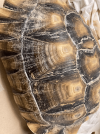SasquatchTortoise
Active Member
So the last few weeks we have had consistent rain, and the greenhouse which our sulcata stays in during the winter had started to flood a bit (the ground is dirt). Along with some freezing temperatures, we had to take her inside to the laundry room- it's pretty much empty in there- nothing she can really hurt herself on. However being in closer quarters with "her" (probably a him, I have seen an unusual looking... anyways) made me notice something I originally attributed to erosion or damage from our hard and rocky clay soil-


I'm no photographer, and the lighting makes the peeling (if any) more severe than it actually is- it's more of a 'thicker' area of shell. the darker spot- that definitely looks darker than it used to be- they used to just look eroded from entering and exiting her burrow, but they areas don't seem to have damage, except scratches from rough soil(?). also- the two peeled off areas on the center left in the middle of the scute- those are very old, and I am much more certain that those came from injury to a rock in the roof of his/her burrow (at least, that's what I thought at the time- there was a large, somewhat pointy stone embedded there). and as a side note, she was just born with the tiny scute on the right


There is some small chipping in this image away from the growth rings, I believe. The white growth lines at the edges of her scutes seem thicker than others' I have seen, I do not know if that is a cause for concern. In the second Image- He has some tiny flakes on the shell in a few places- in the image, they make the shell look lighter but they almost look like skin flakes up close. I haven't seen any other pictures that look exactly like this
What I'm guessing this is all from:
1. wear from entering and exiting her burrow, but it hasn't seemed to heal. If anything it has gotten a little worse (maybe, or I could just be imagining it). Some of it definitely started this way
2. a few details about housing- she has a night box for winter, inside of a greenhouse so she can walk around a little more I make sure the temp stays above ~70-75 F and may only dip for a very short time (i.e., I forget to close the door early). If it gets really cold, I sometimes have to throw in an old lamp to generate a little extra heat, but I had to do this more often this winter because of the excessive moisture. I am fixing this ASAP (switching the heat panel for a really small space heater I have), but she may have gotten too close to the light source, drying the shell(?).
3.Our winters usually have more frequent dry and warm periods. But since this winter has been different, I haven't had as many opportunities to soak her.
4. Admittedly, I didn't find this site and/or all of the good information they provide until after I got "her" and didn't know how crucial water/ humidity was at a young age.
5. Just guessing- I have no idea- but perhaps shell rot originally entered through those injuries from the rock, and areas that look like someone took a little sandpaper to them.
Sorry if I loaded too much information onto here. I feel terrible for writing it off as a side effect of digging. It just hasn't improved much, and that concerns me. Anyone have knowledge of this, and what I should do?


I'm no photographer, and the lighting makes the peeling (if any) more severe than it actually is- it's more of a 'thicker' area of shell. the darker spot- that definitely looks darker than it used to be- they used to just look eroded from entering and exiting her burrow, but they areas don't seem to have damage, except scratches from rough soil(?). also- the two peeled off areas on the center left in the middle of the scute- those are very old, and I am much more certain that those came from injury to a rock in the roof of his/her burrow (at least, that's what I thought at the time- there was a large, somewhat pointy stone embedded there). and as a side note, she was just born with the tiny scute on the right


There is some small chipping in this image away from the growth rings, I believe. The white growth lines at the edges of her scutes seem thicker than others' I have seen, I do not know if that is a cause for concern. In the second Image- He has some tiny flakes on the shell in a few places- in the image, they make the shell look lighter but they almost look like skin flakes up close. I haven't seen any other pictures that look exactly like this
What I'm guessing this is all from:
1. wear from entering and exiting her burrow, but it hasn't seemed to heal. If anything it has gotten a little worse (maybe, or I could just be imagining it). Some of it definitely started this way
2. a few details about housing- she has a night box for winter, inside of a greenhouse so she can walk around a little more I make sure the temp stays above ~70-75 F and may only dip for a very short time (i.e., I forget to close the door early). If it gets really cold, I sometimes have to throw in an old lamp to generate a little extra heat, but I had to do this more often this winter because of the excessive moisture. I am fixing this ASAP (switching the heat panel for a really small space heater I have), but she may have gotten too close to the light source, drying the shell(?).
3.Our winters usually have more frequent dry and warm periods. But since this winter has been different, I haven't had as many opportunities to soak her.
4. Admittedly, I didn't find this site and/or all of the good information they provide until after I got "her" and didn't know how crucial water/ humidity was at a young age.
5. Just guessing- I have no idea- but perhaps shell rot originally entered through those injuries from the rock, and areas that look like someone took a little sandpaper to them.
Sorry if I loaded too much information onto here. I feel terrible for writing it off as a side effect of digging. It just hasn't improved much, and that concerns me. Anyone have knowledge of this, and what I should do?